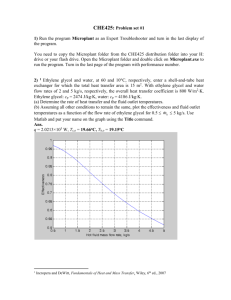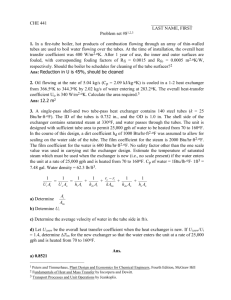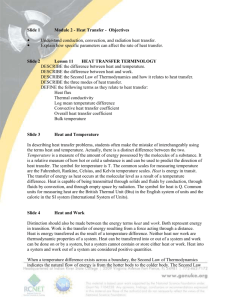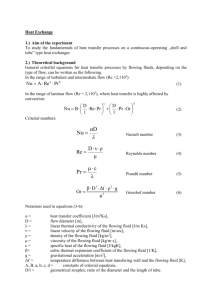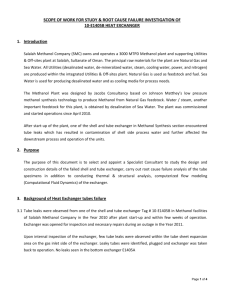CHEM-E7140_HX_homework_1_2015
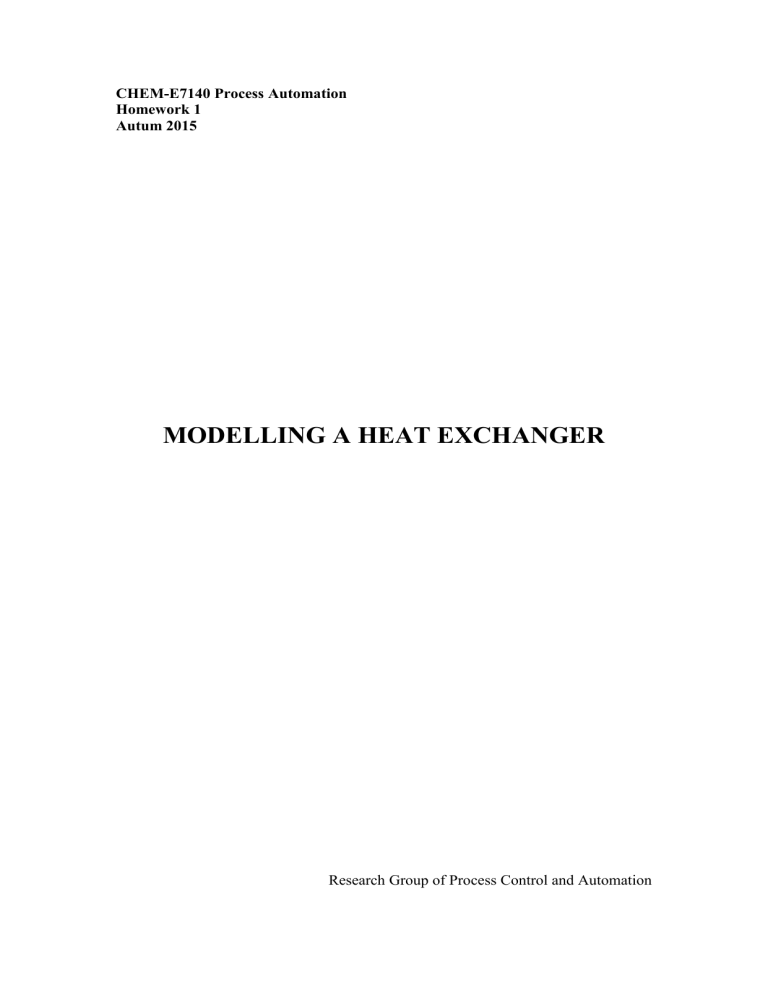
CHEM-E7140 Process Automation
Homework 1
Autum 2015
MODELLING A HEAT EXCHANGER
Research Group of Process Control and Automation
1. Objective
In this exercise you will get acquainted with physical-chemical modelling by creating a model for a tube heat exchanger located in the machine room of the Department of
Chemical Engineering. You will learn the basic concepts of compiling a dynamic model, by compiling and handling model equations. You will also practice the principles of simulation and use modern simulation software.
2. Progression of the work
The groups will first compile model equations describing the heat exchanger. These equations are used for creating a useful model of the process. A Matlab function is implemented according to this mathematic model, which is used in the simulation.
3. Facility
In this work, you will use a double tube heat exchanger operating in counter flow mode. In the heat exchanger, hot water is cooled down. The hot water runs on the tube side, and the cold water (used for cooling) runs on the jacket side. Volume flows and temperatures in the input and output flows are measured. You can get acquainted with the machinery in the machine hall in F wing of the Department of Chemical
Engineering.
4. Model equations
4.1 Examine the differential energy balance of the heat exchanger in the short end of the exchanger, the length of which is
x on both the tube and the jacket side. The calculation of the coefficient of thermal transmittance is based on the inner area of the tube. Derive partial differential equations when
x approaches zero.
Assume that there is plug flow in both the tube and the jacket side, the heat exchanger is ideally isolated from the surroundings, the heat capacities of the walls are insignificant, the density and heat capacity of water are constants. Also, assume that axial heat conduction does not exist.
You can use these equations to derive model equations that very well describe the heat exchanger. However, in such a case the model would become very complicated
(incl. integration of the state variable) and this would mean that it is not very well suited for a numeric calculation tool. Try to simplify the model so that the calculation time diminishes without deteriorating the model. One possible way to do this is as follows:
4.2 Divide the heat exchanger into N parts in proportion to the state variable, and then assume that the tube and the jacket side of each part are ideal mixers in proportion to the temperature. Write equations describing the heat exchanger when the temperatures are the state variables in parts 1 – N. The
controls are the temperatures and the volume flows of the input flows. Assume that the coefficient of thermal transmittance is constant.
The calculation becomes very simple and fast when using these equations.
4.3 Create a Simulink model according to the previous section, when the calculation of the coefficient of thermal transmittance is made according to appendix 1. The S function described in the Matlab demonstration might be suitable for implementing the model.
You should first implement (and test) most of the calculations using your own functions in order to ensure that the function including the actual model is as simple as possible.
Simulate with N = 5 and N = 10. Check the results and write conclusions.
6. Work instructions
Your assignment should be returned by 16:00 on 2.10.2015
. Return your assignment to Jukka Kortela jukka.kortela@aalto.fi
The returned work should include answers to all the questions presented, and should be documented in an appropriate way, including a hard copy of the Simulink model, and the Matlab and Simulink files. The aim of this document is to present the results you received, and to practice writing a document – imagine that you are presenting the results of the ”real” project to an outsider, and think about how to prepare a document so that all the difficult issues can be easily understood. The document will not be returned to you to fix the format of the document – the idea is to pay attention to the purpose of reports, publications and documents, and also to emphasize clarity and consistency instead of format and stiffness.
To become approved, the document must also include model equations that have been derived correctly, as well as the Simulink model that is created correctly and predicts the process behavior well. The answer to question 5.2 should show that the group understood all the restrictions of their model.
Appendix 1. Calculating the coefficient of thermal transmittance.
This method for calculating the coefficient of thermal transmittance is presented in more detail in the Laboratory Work Instructions of Chemical Engineering.
Symbols:
U area coefficient of thermal transmittance based on the inner surface h i heat-transfer coefficient of the inner tubes, W/m
2
K h o heat-transfer coefficient of the exterior of the inner tubes,
W/m
2
K l length of the heat exchanger, m d i inner diameter of the inner tube, m d o outer diameter of the inner tube, m d u inner diameter of the outer tube, m d s hydraulic diameter (d i
on the tube side, d u
-d o
on the jacket side),m v velocity of flow, m/s
S
thickness of the inner tube’s wall, m p thermal conductivity of the tube’s material, W/mK
T
temperature of the flowing substance, K density of the flowing substance, kg/m
3 thermal conductivity of the flowing substance, W/mK viscosity of the flowing substance, kg/ms
C p specific heat capacity of the flowing substance kJ/kgK
The coefficient of thermal transmittance of the internal surface area can be calculated as follows, when the heat transfer resistance of the dirt layer is assumed to be insignificant:
1
U
d i h o d o
1 h i
S
p
1
S d i
Coefficients of heat transfer can be calculated from the equation: h
0 .
023 C p
1 / 3
4 / 5
7 / 15
2 / 3 d s
1 / 5 v
4 / 5
The following values of water are used:
C p
= 4.18 kJ/kgK
= 995 kg/m
3
= 0.6 W/mK
Viscosity of water is calculated from the equation:
0 .
245
2 .
2869 * 10
3
T
7 .
16967 * 10
6
T
2
7 .
53112 * 10
9
T
3
The following characteristics are used for the heat exchanger.
d i
= 0.015 m d o
= 0.021 m d u
= 0.032 m l = 1.0 m
p
= 16.26858 W/mK
